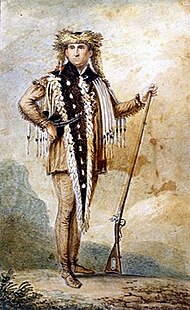Tippet
A tippet (or tappit) could also be the long, narrow, streamer-like strips of fabric - attached with an armband just above the elbow - that hung gracefully to the knee or even to the ground.
[1] In later fashion, a tippet is often any scarf-like wrap, usually made of fur, such as the sixteenth-century zibellino[2] or the fur-lined capelets worn in the mid-18th century.
Clergy who are entitled to wear medals, orders, or awards sometimes fix them to the upper left side of the tippet on suitable occasions (such as Remembrance Sunday in the Church of England).
The tippet is not the stole, which although often worn like a scarf, is a Eucharistic vestment, usually made of richer material, and varying according to the liturgical colour of the day.
In the British Army, all serving chaplains are issued with a tippet to be worn directly over battledress when ministering in conflict zones.
The black preaching scarf (or rarely blue, grey, or green) is also worn by some Scottish Presbyterian ministers and other non-conformist clergy.



